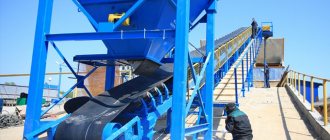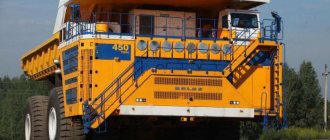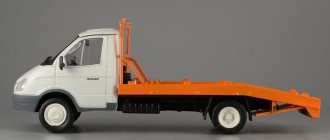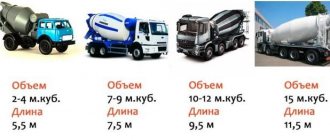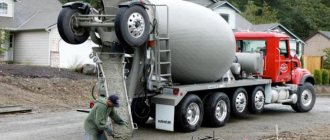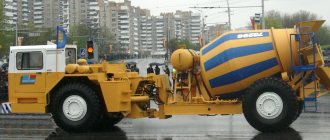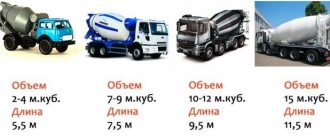eb2 b0f aa8 946 9d2 e12 458 f40 37b 369 bba af3 62c 7cc dd9 016 be5 a27 0ff a14 33e e63 172 a6d ec8 10f 109 d2e 4a4 59f 89a 889 76b 092 f7b b1c 1f8 9d4 80d e1a 076 c69 20e 8bb 465 65a 175 e58 c3e 841 36a e48 b28 8bc 461 301 5ec a87 202 c8d a50 86d 942 d4c 4f7 123 3c0 e80 b9e 534 383 1d8 dbd dc2 9ed e64 372 a61 632 971 188 2a7 16f 859 1 41 f5b 4cc 136 5f7 6c5 d4c b19 4ae c46 0a1 b8f 946 d26 8c5 fd0
In the city - from 7 cubic meters and above. The main reasons why there are no small mixers:
What is the volume of mixers (concrete mixer trucks)?
In practice, most often - 5 and 7 cubes, machines with 4 and 6 cubes are less common, somewhere there are even very small mixers with a volume of 2 cubes. Outside the city there are often narrow roads with closed turns, and in many places you cannot drive cars with a capacity of more than 5 cubic meters. In the city - from 7 cubic meters and above. The main reasons why there are no small mixers:
- due to large volumes of one-time deliveries, it is unprofitable to keep small mixers,
- Small mixers are most often not new, have toxic emissions, and with them there is a greater risk of getting fined.
How much does a mixer with concrete weigh (loaded)?
The weight of 1 cubic meter of concrete is 2.4 tons, the weight of a 5-cubic-meter mixer is 11 tons, and a 7-cubic-meter mixer is a little over 12 tons. That is, a loaded 5-cubic mixer weighs 23 tons, a 7-cubic mixer weighs 29 tons.
What length are the sleeves of mixers?
Usually - from 1.5 to 2 meters. If additional devices are used, they may be the property of the driver who installed the gutter himself and may ask for additional payment for its use. The following photograph is shown on the website of the Tigarbo mixer manufacturer: This is the maximum configuration of the gutter with 3 sections (1 main and 2 additional). In practice, they most often consist of 1 or 2 sections.
What size is the mixer that will come to me?
The specific size of the machine depends not only on the volume of the mixing drum, but also on the brand of chassis on which it is installed. Only the width remains unchanged - 2.55 (large) or 2.50 meters (all other mixers). The average dimensions and number of mixer axles in depending on the volume is presented in the table below:
| Volume, m3 | Number of axes | Length, m | Height, m | Width, m |
| 4 | 2 | 7,35 | 3,40 | 2,50 |
| 5 | 3 | 7,40-8,00 | 3,50 | 2,50 |
| 6 | 3 | 7,80-8,50 | 3,60 | 2,50 |
| 7 | 3 | 8,20-8,80 | 3,60-3,75 | 2,50 |
| 8 | 3 | 8,40-9,00 | 3,70-3,85 | 2,50 |
| 9 | 3 | 8,50-9,20 | 3,70-3,95 | 2,50-2,55 |
| 10 | 4 | 9,30-9,45 | 3,80-4,00 | 2,55 |
As a rule, a lower value is a mixer based on KAMAZ, a larger value is based on a MAZ, Ural or foreign cars. Mixers based on all-terrain vehicles were not included in the calculation of dimensions. More detailed information about the dimensions of mixers depending on the manufacturers of the chassis and mixing drum can be found in the “Encyclopedia” section on the pages of the manufacturers Tigarbo (the largest selection), TZA, Becema. Other manufacturers do not provide such detailed data.
What to do if the standard gutter length is not enough?
The most commonly used options are to construct the gutter yourself (with workers) or use a concrete pump, which will deliver concrete over a distance much greater than any gutter.
How long can it take to unload the mixer?
Each manufacturer has its own standard, but for averaging, we can say that 1 cubic meter should be unloaded in no more than 10 minutes; for additional downtime, an additional fee of 1,200 rubles per hour of downtime is charged.
How is concrete discharged from the mixer?
The concrete mixing barrel uses the “Archimedes screw” mechanism. When the barrel rotates clockwise, the concrete moves from one trench to another, but does not spill out of the barrel and still remains in it. But as soon as the barrel begins to rotate counterclockwise, the concrete is unloaded from the barrel, rising from the very bottom to the top.
I was told that I still need to give the mixer a chance to rinse. What it is?
Yes, after pouring, the mixer driver washes the chute so that concrete residues do not harden on it. A relatively small amount of water is enough for this (Washing outside the construction site is fraught with fines, so concrete suppliers check whether there is a site where water and concrete residues will remain after washing. The Buyer is obliged to provide access roads to the facility to which the goods are delivered, allowing for the unhindered unloading (delivery) of goods using the Supplier's vehicles and special equipment. If access roads to the facility are not provided, the Buyer is obliged to ensure the evacuation of vehicles and special equipment for at his own expense and on his own. The buyer is obliged to provide a place for washing vehicles and special equipment at the construction site.
Most often, suppliers request that the mixer driver be available to perform on-site washing. Therefore, the customer needs to prepare a site where it will be possible to drain the used water with the remaining concrete.
Questions and answers about concrete delivery by concrete mixer trucks (mixers, ABS)
What volume are mixers (concrete mixers)? In the Moscow region, the most common ones are 7 and 9 cubic meters; machines of 4, 5 and 6 cubic meters are less common; in some places there are even very small mixers with a volume of 2.5 cubic meters.
Outside the city there are often narrow roads with closed turns, and many places cannot be reached by cars with a capacity of more than 5 cubic meters. In Moscow, the volume of cars is from 6 cubic meters (and 6-7 cc cars are not kept everywhere). The main reasons why there are no small mixers:
- due to the large volumes of one-time deliveries, it is unprofitable to keep small concrete mixers,
- small mixers are most often not new, have toxic emissions, and with them there is a greater risk of getting fined,
- In addition, with the tightening of fines for overloading in 2015, many factories switched to delivering incomplete vehicles, and a 5-cubic-meter car can only carry 2-3 cubic meters.
The “Encyclopedia” section provides more detailed information on the products of the leaders of the Russian ABS market, the Tigarbo and TZA companies. Due to lack of demand, companies are reducing the production of small-volume concrete mixers.
What is the length of the hose for concrete mixers (mixers)? Typically the length of the tray (gutter) is from 1.5 to 2 meters. If additional accessories are used, they may be the property of the driver who installed the gutter himself and may require additional payment for its use.
The photo below shows a mixer with a maximum set of trays of 3 sections (1 main and 2 additional). In practice, the gutter most often consists of 1 or 2 sections.
What to do if the standard gutter length is not enough?
- if the distance is up to 5 m: construct an additional gutter (sleeve) yourself (by workers),
- at distances greater than 5 m, the concrete mixture will not flow along the tray on its own due to the low angle. You need to: either use a concrete pump that will deliver concrete over a distance significantly greater than any gutter,
- or hire a large number of workers who will manually (with shovels) drag the mixture along the tray (this option is chosen for pouring into a window or basement, where using a pump is problematic).
Sometimes there are options to use conveyor belts or special wide pipes - but they are quite rare and you should not count on them by default.
What are the sizes of mixers of different sizes? The specific size of a concrete mixer depends not only on the volume of the mixing drum, but also on the brand of chassis on which it is installed. Only the width remains unchanged - 2.55 (large) or 2.50 meters (all other mixers). The average dimensions and number of mixer axes depending on the volume are presented in the table below:
| Volume, m3 | Number of axes | Length, m | Height, m | Width, m | Curb weight, t |
| 4 | 2 | 7,35 | 3,40 | 2,50 | 10 |
| 5 | 3 | 7,40-8,00 | 3,50 | 2,50 | 12 |
| 6 | 3 | 7,80-8,50 | 3,60 | 2,50 | 11,9-13,5 |
| 7 | 3 | 8,20-8,80 | 3,60-3,75 | 2,50 | 12,2-13,9 |
| 8 | 3 | 8,40-9,00 | 3,70-3,85 | 2,50 | 12,8-15 |
| 9 | usually 3 | 8,50-9,20 | 3,70-3,95 | 2,50-2,55 | 13-15 |
| 10 | 4 | 9,30-9,45 | 3,80-4,00 | 2,55 | 15,3-17,2 |
| 11 | 4 | 9,78 | 3,78 | 2,55 | 16,6 |
| 12 | 4 | 9,94-10,36 | 3,82-3,95 | 2,55 | 16,7-19 |
As a rule, the lower value is a mixer based on KAMAZ, the larger value is concrete mixers based on MAZ, Ural or foreign cars (MAN, Mercedes, Iveco, Renault, Ford, Volvo, Scania, Mitsubishi, Hovo, KAMK, Shakman and other brands). Concrete mixers based on all-terrain vehicles (KrAZ, KAMAZ) were not included in the calculation of dimensions.
More detailed information about the dimensions of mixers depending on the manufacturers of the chassis and mixing drum can be found in the “Encyclopedia” section on the pages of the Tigarbo (largest selection) and TZA manufacturers. Other manufacturers do not provide such detailed data.
loaded mixer with concrete weigh Will it be able to travel to my facility? The weight of 1 cubic meter of concrete is 2.4 tons, the weight of a 5 cubic meter mixer is 12 tons, and a 7 cubic meter mixer is a little over 12 tons. Thus, a loaded 5-cubic-meter concrete mixer weighs 24 tons, a 7-cubic-meter concrete mixer weighs 29 tons, and a 9-cubic-meter concrete mixer weighs 35 tons. Due to their heavy weight, concrete trucks require special attention to the road surface. Even if a ZIL arrived at the site with sand (not to mention a passenger car), this does not mean at all that a mixer will be able to drive through it: a ZIL has a total weight of 10-15 tons, while a concrete mixer has 2 times more. You can navigate as follows:
- if there is a hard surface (asphalt, slabs) laid towards the object, the mixer will be able to drive over it. Rolled soil is a hard surface only in dry weather; in rainy weather it can be washed away. If a car cannot enter an object on a paved road, it is the driver’s fault. But there is a note: in some cases, it is not the hardness of the surface that is decisive, but the freedom of space - it is problematic for even a small mixer to drive on narrow roads with closed turns, not to mention large ones,
- grass, soil, snow, sand and crushed stone are not hard surfaces; in some cases driving over them is possible, in others not, you need to navigate according to the specific situation. Since a concrete mixer is expensive and has a high center of gravity with the risk of overturning, the possibility of passage is determined by the driver - the person responsible for the safety of the machine.
Is it possible to deliver concrete using dump trucks - or do you have to use concrete mixer trucks (also called mixers, concrete trucks or concrete mixers)?
According to clause 9.1. GOST 7473-2010 “concrete mixtures are delivered to the consumer by specialized types of transport designed for the transportation of concrete mixtures. By agreement between the manufacturer and the consumer, it is allowed to transport rigid concrete mixtures by dump trucks.” In practice, rigid mixtures are called lean concrete - concrete with a reduced content of cement and a high content of crushed stone. By analogy, there is rich concrete (respectively, with a reduced content of crushed stone and a high content of cement - not used in real practice) and ready-mixed concrete (according to a standard recipe).
Ready-mixed concrete is considered a flexible mixture, for which mobility is standardized (from P1 to P4), lean concrete is considered a rigid and super-rigid mixture (it spreads for a long time or for a very long time under the influence of its own weight, for which rigidity (from Zh1 to Zh4) and super-rigidity (from SZh1) is standardized to SZh3).
Due to its rigidity, when transporting lean concrete in a mixer, there is a very high risk that the concrete will not be able to be dumped out of the barrel, which is why a rule on transportation in dump trucks has been added to GOST. Due to the same risk, road concrete (with mobility P1) is also transported in dump trucks. Therefore, when ordering lean concrete:
- clarify and make sure that there is no misunderstanding in terminology (sometimes lean concrete is called any low-strength concrete, regardless of consistency - and this is incorrect),
- If you figure out that what you need is a hard concrete mixture, don’t be surprised that it is delivered in dump trucks. Moreover, beware of those who offer to deliver it in mixers, because these are usually middlemen (who jeopardize other people's equipment, not their own) or not very experienced employees.
How can I make sure that the mixer contains the exact volume of concrete indicated on the delivery note? A detailed answer to this question is described in a separate article.
How long can it take to unload the mixer? Each manufacturer has its own standard, but for averaging, we can say that 1 cubic meter should be unloaded in no more than 10 minutes; for additional downtime, a fine of 500 to 1000 rubles per hour of downtime is charged.
How is concrete discharged from the mixer? The concrete mixing barrel uses the “Archimedes screw” mechanism. When the barrel rotates clockwise, the concrete moves from one chute to another - but does not spill out of the barrel and still remains in it. But as soon as the barrel begins to rotate counterclockwise, the concrete is unloaded from the barrel, rising from the very bottom to the top.
This video shows a concrete mixer with 1 main and 2 additional chute sections.
Pay attention to the moment of changing the direction of rotation.
I was told that I still need to give the mixer a chance to rinse. What it is? Yes, after pouring, the driver of the concrete mixer washes the gutter so that the remaining concrete does not splash out onto the road or harden on it. A relatively small amount of water is enough for this (
50 l). Carrying out flushing off-site can result in fines, so suppliers often check to see if there is an area where water and concrete residue will remain after flushing.
Features of the technology
Modern concrete mixers are trucks equipped with a rotating concrete mixer. This allows machines to not only deliver material to a site, but also produce it during transportation. Due to the fact that the solution is constantly in motion due to the rotation of the drum, it does not set, which allows the material to be transported over long distances.
It must be said that the history of the emergence of this construction equipment goes back to the beginning of the last century, however, this equipment became widespread in our country in the post-war period. Of course, a lot of time has passed since then, and the design of the machines has been significantly improved.
As a result, modern concrete mixer trucks have a number of additional functions. In addition, they can be equipped with a device for heating the mixture and thermal insulation, which allows the concrete not to freeze at low temperatures.
Thus, we can distinguish three main purposes of this type of equipment:
- Production of concrete mixtures from dry components during transportation from a special installation to a construction site.
- Preparation of mortar at the construction site.
- Transportation of concrete solution with periodic mixing to the construction site.
Note! Modern concrete mixers can be operated at ambient temperatures from -20 to +40 degrees Celsius.
In the photo - pouring concrete
Advantages
The use of this type of equipment in construction has a number of advantages, among which are:
| Versatility | A concrete truck can provide concrete for both small private construction and large multi-storey buildings. |
| Mobility | As mentioned above, the main advantage of these machines is the ability to transport concrete over long distances. A fully loaded vehicle can travel at a speed of about 60 km/h. Moreover, during transportation the material is not exposed to the environment. |
| Concrete preparation speed | The machine allows you to prepare the solution on the construction site in a short time. |
| Ease of unloading | A concrete truck with a hose can not only deliver the solution, but also pour it into the formwork. |
| Economical | Since the solution is prepared during delivery, its price is lower than when produced on stationary equipment in a factory. |
Advice! If it is impossible to ensure access for equipment to the pouring site, use a special pump to deliver concrete with flexible hoses.
Types of concrete mixers
Concrete mixer trucks come in different types, as they are designed for different construction jobs.
Their main differences are in the following points:
- In the location of the mixing container and the direction of discharge of the solution . Unloading can be done backwards or forwards. In the first case, the operating instructions for the concrete mixer require operator participation during unloading.
If concrete is unloaded backwards, the driver can control this operation with his own hands.
- In concrete mixer drive type . It can be mechanical, hydraulic or hydromechanical. The most popular recently are concrete mixers with hydromechanical transmission, which allows you to adjust the drum speed.
Four-axis model with pump and mixer
- Another important difference between concrete mixer trucks is the volume of the concrete truck mixer, which ranges from 1.5 to 12 cubic meters . For small private construction, a small concrete mixer for several cubes is enough.
If the object is large, then use a concrete mixer with a drum volume of 9-12 cubic meters. In some cases, several machines are used simultaneously to deliver and prepare the solution.
- Also the difference lies in the type of chassis . The mixer can be installed on a truck platform or in the form of a semi-trailer. It should be noted that the number of chassis axles depends on the volume of the tank; for large-volume mixers, three-axle or even four-axle chassis are used.
Note! The larger the tank volume, the greater the height of the concrete truck. You should pay attention to this parameter if the access to the object is limited in height by any obstacles.
The volume of the concrete truck is 9 cubic meters
Construction of concrete mixers
Mixer device
On cars, gravity-driven reversible concrete mixers with a pear-shaped drum are used. The drum must be inclined to the horizontal plane at an angle of 10-15 degrees.
There are helical blades inside the container. When the drum rotates in one direction, they ensure mixing of the solution, and when rotated in the other direction, the solution is completely unloaded.
It should be noted that modern concrete mixer trucks are equipped with a water supply system, which will allow the drum to be flushed of the remaining mixture. They may also have functions such as weighing and dosing. This allows you to prepare high-quality concrete with certain technical characteristics.
Concrete mixer based on a KamAZ vehicle
Platform
Serial trucks are usually used as platforms. Among domestic vehicles, KAMAZ vehicles are the most popular. Moreover, they have become widespread not only in the CIS countries, but also beyond their borders.
Also, KrAZ and MAZ vehicles are often used as platforms for concrete mixers. Among foreign brands, Iveco, MAN, Scania, etc. equipment are very popular.
Necessary tools and equipment
Concrete mixer To prepare concrete for pouring and the trays themselves, you will need certain tools. These can be devices operating from a 220 V electrical network, as well as hand tools:
- two shovels - scoop and bayonet;
- trowel or trowel;
- a wheelbarrow or bucket with which concrete can be transported and poured into the formwork.
The following power tools are required:
- concrete mixer (if you don’t have one, you can borrow it from friends or rent it);
- a hammer drill or impact drill, as well as a mixer attachment (if there is no concrete mixer, and the solution will be mixed by hand).
Shovels are needed to throw the solution into the concrete mixer, and then pick up concrete from a wheelbarrow and pour it into the formwork. A trowel is usually used to level the top layer of the tray being poured.
As you know, gone are the days when concrete was delivered by dump trucks. Now concrete mixer trucks (ABS or mixer) are used to deliver concrete mixture to the site. The task of ABS according to GOST is to exclude the possibility of precipitation getting into them, disruption of homogeneity, loss of cement mortar, and also to ensure the protection of the mixture en route from exposure to wind and sunlight. The safety and uniformity of the concrete mixture during transportation is ensured by the rotation of the drum.
Description of concrete mixer trucks
As you know, gone are the days when concrete was delivered by dump trucks. Now concrete mixer trucks (ABS or mixer) are used to deliver concrete mixture to the site. The task of ABS according to GOST is to exclude the possibility of precipitation getting into them, disruption of homogeneity, loss of cement mortar, and also to ensure the protection of the mixture en route from exposure to wind and sunlight. The safety and uniformity of the concrete mixture during transportation is ensured by the rotation of the drum. Inside the drum there are spiral blades. When rotating in one direction (during loading and transport), the blades drive the mixture deeper into the drum. While the concrete mixer truck is moving with concrete mixture and at temporary stops, rotation of the drum in the opposite direction is strictly prohibited. When rotating in the other direction (during unloading), the Archimedes Screw mechanism is used, with the help of which the mixture is unloaded. Preparation of the concrete mixture is possible directly in the concrete mixer truck during transportation, when cement, water and aggregates are loaded into the drum. In Russian concreting practice, the more common scheme is to transport ready-mixed concrete mixed at the plant.
Volumes of concrete mixer trucks
The most popular on the Russian market is KAMAZ ABS with a volume of 7 cubic meters, followed by 9 cubic meters. The top three are closed by small two-axle mixers based on Japanese right-hand drive trucks with a volume of 2 to 5 cubic meters. ABS with a barrel volume of 7 cubic meters. as a rule, it is loaded at 6-6.5 cubic meters, and with a barrel volume of 9 cubic meters. at 8-8.5. Not filling up to full volume is associated with a number of factors:
- Preventing spillage of moving concrete during transportation.
- Reducing the load on tires, frame, subframe and chassis ABS.
- The smaller the vehicle’s loading volume, the more passable it is over rough terrain.
Concrete can be prepared in two ways:
Conclusion
A concrete truck, in fact, is an alternative to bulky stationary installations for preparing concrete, but unlike them, it is mobile. In addition, a wide variety of types of concrete mixer trucks allows them to provide concrete to almost any type of construction site. As a result, these machines are one of the most common types of construction equipment (learn how to pour a concrete floor yourself here).
You can get more information on this topic from the video in this article.
Operating principle
When preparing a working mixture, one of the most important factors affecting the quality of the final product is uniform mixing of the loaded components. This is ensured by the presence of a rotating drum and a screw mixer.
Structurally, the stirrer is made in the form of a fixed Archimedean screw. Mixing is carried out by rotating the drum. When loading the initial components, due to rotation, the mixture is pushed along the surface of the screw deep into the container and mixed until homogeneous.
In order to unload the finished solution, the direction of rotation of the drum is reversed. The screw attachment, due to the rotation of the drum, in this case will empty the entire volume of the mixer, actually pushing the blades with concrete out.
Pouring concrete from a mixer
Not a single building is complete without the construction of a foundation. Compliance with the technological process of laying the concrete mixture affects the durability and strength of the structure. They lay the foundation with special responsibility, adhering to the order of work. The construction of the foundation begins with marking, digging a hole, reinforcement and installation of formwork. After the preparatory work is completed, the concrete begins to be poured.
The process of laying the solution is carried out manually or using specially designed equipment and mechanisms. What type of fill should I choose for the construction of the structure? This is a decision for the builder to make: either it will be an economical option to prepare it yourself, or a more expensive, but also high-quality option of using an automated concrete mixer.
Benefits of using a mixer
The mixer is an automated concrete mixer that delivers a specified volume of concrete to the workplace. The advantages of mixers are as follows:
- laying with a mixer is carried out over several hours, which reduces the time for construction work;
- the quality of the finished solution from the mixer is higher than that prepared by hand;
- the mixture from the concrete mixer comes out to the required consistency, which simplifies the work of leveling the surface;
- pouring concrete from a mixer is carried out throughout the day, and when making the mixture manually, it may take a week to pour the solution;
- has no difficulties in calculating the amount of the required solution;
- the mixture prepared at the factory contains additives, plasticizers, and modifiers that improve the waterproofing of the building mass;
- obtaining a homogeneous structure by mixing the mixture in a concrete mixer during transportation.
Return to contents
What you should pay attention to
When ordering delivery of the mixture with a mixer, you need to prepare:
- Provide access roads for ABS. If the volume of monolithic work is large, it is worth identifying several points for unloading.
- The site for parking the ABS, from where the supply will take place, is selected no closer than 8 meters from the edge of the pit. The slope should not exceed 5%, dimensions should not be less than 6x8 meters.
- It is advisable to use a vibrating tool to compact the concrete mixture. This will improve the quality of work.
- Provide a place for draining excess mortar - install formwork, waterproofing and reinforced frame for secondary structures - a fence or barbecue. Place the remaining unused concrete in the prepared form.
- To avoid underloading, order delivery only from trusted suppliers. Usually these are large manufacturing plants.
- Plan delivery for the morning in order to have time to use up the entire amount of mixture brought.
- For large volumes of monolithic work, create a schedule for the arrival of mixers, which should not be too tight. It is better to leave a gap of at least 2 hours between flights.
- The ABS driver is required to provide a consignment note and a quality certificate for concrete indicating the volume and brand.
Delivery of concrete using a KamAZ mixer is a solution to many problems. Transportation over a long distance will not affect the properties of the solution, since constant stirring prevents the mixture from setting, separating, and losing moisture. When ordering finished material, the time required for monolithic work is reduced several times. The quality of the construction is higher than when made manually or using an electric concrete mixer.
From the ground level the device is 5-15 degrees for a thin solution and 20-30 degrees will be needed for dense concrete. Then the solution from the mixer or concrete mixer, when it gets into the tray, will move along the riverbed on its own.
Disadvantages of solution preparation
Builders who want to save money make the mortar themselves, but completely forget that when laying the mixture in parts, the foundation ends up with worse technical characteristics. The concrete base turns out to be of poor quality due to the fact that stale cement, prepared many hours before its production, is used to lay it.
Construction companies provide concrete mortar, which is made using mixers with a volume of two to ten cubic meters. Manufacturing companies with a large turnover of products use specially designed vehicles to transport concrete mortar. The use of special equipment for transporting the mash increases the cost of the finished mixture.
Preparatory work
Pouring the foundation with an automated concrete mixer begins with preparing the work site where the construction of the facility is planned. Preparatory work consists of marking and digging a trench, gravel is laid at the bottom and formwork is installed. When laying the mixture along the entire perimeter of the object, it is important to control the evenness of the top layer of coating; for this, use a stretched fishing line.
Next, prepare the construction site on which it is planned to lay the working mixture. Before pouring concrete, check its hardness after transportation. If the mixture has hardened, pre-prepared water is poured into it. The surface on which it is planned to lay the concrete solution is cleared of construction debris and dust.
Why do you need a gutter?
Concrete solution comes from a concrete mixer there. The recommended length of the device is 1.2-1.5 m, then the concrete will be distributed evenly over the formwork. This is possible by providing free access to all areas of the building, including the most inaccessible ones.
Concrete delamination is prevented - without using this product, the thick solution will concentrate in the pouring area, and the liquid mass will spread over other areas. The correct approach to work will extend the life of the foundation by improving the quality of installation.
The gutter will reduce the mechanical impact on concrete - there will be no need to use shovels, and the work process will speed up.
Using this method, you can calculate the amount of mixture and the total load of loaded equipment on the road surface.
How to properly lay concrete?
During the process of laying the concrete mixture for the construction of the foundation, it is carefully compacted using deep vibrators. Tamping can also be done using ordinary steel reinforcement. The concrete composition is compacted until air bubbles disappear, which negatively affect the cast structure of the concrete base for buildings and structures. After removing air bubbles, begin leveling the top layer of the base using a trowel.
In some cases, to achieve a good result, you should not save on building materials and equipment, but use automated mechanisms that allow you to lay high-quality concrete mortar.
Concrete mixer trucks (mixers)
What is the volume of mixers (concrete mixer trucks)?
In practice, most often - 5 and 7 cubes, machines with 4 and 6 cubes are less common, somewhere there are even very small mixers with a volume of 2 cubes. Outside the city there are often narrow roads with closed turns, and many places cannot be reached by cars with a capacity of more than 5 cubic meters.
In the city - from 7 cubic meters and above. The main reasons why there are no small mixers:
- due to large volumes of one-time deliveries, it is unprofitable to keep small mixers,
- Small mixers are most often not new, have toxic emissions, and with them there is a greater risk of getting fined.
How much does a mixer with concrete weigh (loaded)?
The weight of 1 cubic meter of concrete is 2.4 tons, the weight of a 5 cubic meter mixer is 11 tons, and a 7 cubic meter is a little over 12 tons. That is, a loaded 5-cubic mixer weighs 23 tons, a 7-cubic mixer weighs 29 tons.
What length are the sleeves of mixers?
Usually - from 1.5 to 2 meters.
If additional accessories are used, they may be the property of the driver who installed the gutter himself and may require additional payment for its use. The website of the mixer manufacturer Tigarbo shows the following photo:
This is the maximum configuration of the gutter with 3 sections (1 main and 2 additional). In practice, they most often consist of 1 or 2 sections.
What size is the mixer that will come to me?
The specific size of the machine depends not only on the volume of the mixing drum, but also on the brand of chassis on which it is installed.
Only the width remains unchanged - 2.55 (large) or 2.50 meters (all other mixers).
The average dimensions and number of mixer axes depending on the volume are presented in the table below:
| Volume, m3 | Number of axes | Length, m | Height, m | Width, m |
| 4 | 2 | 7,35 | 3,40 | 2,50 |
| 5 | 3 | 7,40-8,00 | 3,50 | 2,50 |
| 6 | 3 | 7,80-8,50 | 3,60 | 2,50 |
| 7 | 3 | 8,20-8,80 | 3,60-3,75 | 2,50 |
| 8 | 3 | 8,40-9,00 | 3,70-3,85 | 2,50 |
| 9 | 3 | 8,50-9,20 | 3,70-3,95 | 2,50-2,55 |
| 10 | 4 | 9,30-9,45 | 3,80-4,00 | 2,55 |
As a rule, a lower value is a mixer based on KAMAZ, a larger value is based on a MAZ, Ural or foreign cars. Mixers based on all-terrain vehicles were not included in the calculation of dimensions.
More detailed information about the dimensions of mixers depending on the manufacturers of the chassis and mixing drum can be found in the “Encyclopedia” section on the pages of the manufacturers Tigarbo (the largest selection), TZA, Becema. Other manufacturers do not provide such detailed data.
What to do if the standard gutter length is not enough?
The most commonly used options are to construct the gutter yourself (with workers) or use a concrete pump, which will deliver concrete over a distance much greater than any gutter.
How long can it take to unload the mixer?
Each manufacturer has its own standard, but for averaging, we can say that 1 cubic meter should be unloaded in no more than 10 minutes; for additional downtime, an additional fee of 1,200 rubles per hour of downtime is charged.
How is concrete discharged from the mixer?
The concrete mixing barrel uses the “Archimedes screw” mechanism.
When the barrel rotates clockwise, the concrete moves from one chute to another - but does not spill out of the barrel and still remains in it. But as soon as the barrel begins to rotate counterclockwise, the concrete is unloaded from the barrel, rising from the very bottom to the top.
I was told that I still need to give the mixer a chance to rinse. What it is?
Yes, after pouring, the mixer driver flushes the chute to prevent any remaining concrete from hardening on it.
A relatively small amount of water is enough for this (
Carrying out flushing off-site is fraught with fines, so concrete suppliers check to see if there is a site where water and concrete residues will remain after flushing.
The Buyer is obliged to provide access roads to the facility to which the goods are delivered, allowing for the unhindered unloading (delivery) of goods using the Supplier’s vehicles and special equipment. If access roads to the facility are not provided, the Buyer is obliged to ensure the evacuation of vehicles and special equipment at its own expense and on its own.
The buyer is obliged to provide a place for washing vehicles and special equipment at the construction site.
Technical characteristics and cost
Supply length 17 meters, volume 9 m³.
Up to 9 m³ - 6000 rubles for 1 unloading.
Over 9 m³ - 600 rub. for 1 m³.
Rearranging the conveyor belt - 1000 rubles/piece.
The minimum payment for delivery within the city is 7 m³.
The minimum payment for delivery within the region is 8 m³.
The unloading time of the concrete mixer truck is 60 (sixty) minutes from the moment of arrival at the site. More than 60 (sixty) minutes are considered downtime and are paid at the rate of 17 (seventeen) rubles for each minute of downtime.
What do you need to know about transporting ready-mixed concrete?
Question: How to properly transport concrete mix to the construction site? What nuances do you need to know in order to get a high-quality mixture for the object?
Proper transportation and unloading of ready-mixed concrete
During the construction of civil and industrial buildings (structures) located within large cities or in their suburbs, it is carried out using ready-mixed concrete, which is ordered from concrete manufacturing plants.
It is not effective to deliver concrete over long distances (more than 70 km), since its cost is very high due to long-distance delivery. Ready-mix concrete can be delivered to a construction site using dump trucks or concrete mixer trucks (popularly called “mixers”).
The main requirements for concrete during its transportation are to preserve its basic properties (design grade strength, mobility and homogeneity) and to prevent the mixture from separating.
Transporting a concrete mixture using a dump truck can be justified over short distances (maximum 15 km, taking into account the good quality of the road surface), since in this case, the concrete mixture often delaminates and requires additional mixing immediately before laying.
Delivery of concrete mix by concrete mixer trucks
Let's briefly look at what concrete mixer trucks are, photo 1.
As noted above, ready-mixed concrete is transported by concrete mixer trucks, which allow the basic properties of concrete to be preserved during its transportation. All concrete mixer trucks are made on the basis of KAMAZ, KRAZ, MERSEDEC, etc. trucks. The machines are equipped with a barrel-shaped container of various volumes, equipped inside with blades for mixing the concrete mixture using an engine.
All concrete mixer trucks have their own classification based on the following criteria:
- drum drive type: mechanical or hydraulic;
- unloading directions: unloading “forward” or “backward”;
- mixer motor type: stand-alone and “engine on chassis”.
Advantages of delivering concrete by concrete mixer trucks
Using concrete mixer trucks to deliver concrete mixture has a number of advantages:
- the concrete mixture can be directly prepared in concrete mixer trucks while on the way to the construction site (a dry mixture of all concrete components is loaded into the drum, and then, when approaching the construction site, the required amount of water is added and a “fresh” concrete mixture is prepared by mixing). This method increases the time to ensure the mobility of the concrete mixture and the permissible transportation distance (100...200 km);
- ensures the homogeneity of the concrete mixture and prevents it from separating;
- protects the concrete mixture from atmospheric influences: sunlight, wind, precipitation, etc.;
- the volume of concrete mixture that can be transported using one concrete mixer truck is 3...12 m 3 ;
- Some concrete mixer trucks are equipped with an additional unloading pipe up to 8 meters long, which allows you to unload concrete mixture in hard-to-reach places.
Depending on the type of concrete mixture and ambient air temperature, the duration of transportation should not exceed 45 minutes, and for some concretes up to 1.5 hours. After this time, the concrete begins to set, which leads to the impossibility of normal laying and a significant decrease in the strength of the concrete. Concrete mixer trucks are capable of operating at temperatures from 0 ○ C to +40 ○ C, and some types even at temperatures from –17 ○ C.
Unloading concrete mixture
The concrete mixture can be supplied to the concreting site in different ways, and this depends on the type of structure, its height relative to ground level, the properties of the concrete mixture and the volume of work performed. Unloading concrete at a construction site can be done in several ways:
- If a specific object or concreting element is located in such a place that a concrete mixer truck can easily drive up, then unloading can occur directly from the mixer into trays, photo 2.
- If a construction site or concreting element is located in a place that is difficult to reach for a mixer, then the concrete mixture is reloaded from a concrete mixer truck into a bucket or concrete pump, and then supplied to the specified location, photos 3 and 4.
Also, when the concreting object is below ground level (pit), then first there is a reloading into a bucket, and then through a vibrating chute directly into the concreting block. If the concreting unit is at a height, the concrete is unloaded into a bucket and then transported to the desired location using cranes. The tub is filled to 0.9…0.95% of the total volume. The capacity of the tub can usually be as follows: 0.3; 0.6; 0.8; 1.0 m3.
- Supplying concrete mixture using concrete spreaders is effectively used for monolithic construction of small-sized foundations. Concrete pavers are self-propelled machines that take on concrete mixture and deliver it to the right place in the right quantity, photo 5.
Required amount of concrete
It is believed that it is ineffective to deliver ready-mixed concrete over a distance of more than 70 km or along a difficult, difficult road, since the cost and delivery time will be high, and there is a high risk of loss of concrete quality during transportation. If large volumes of mortar are needed, and the distance to the concrete plant is large, the optimal solution would be to install a mortar-concrete unit (RCU) directly on site. But if the object is located near a concrete plant, the solution is usually delivered by concrete mixer trucks. A concrete mixer truck is a universal-use machine, with its help you can deliver a small volume of concrete once, and continuously deliver ready-made concrete solution to large construction sites for the construction of large structures and road construction. Now you can move on to choosing ABS. Determine and order the required volume of concrete. It is necessary, by contacting specialists or independently, to accurately calculate the volume of concrete required for your facility and find out what volume of concrete will be output in the mixer, and only then place an order. If the customer needs fewer cubic meters of concrete than the ABS supplier delivers (for example, you need 6 m 3 of concrete, but there is only a mixer for 7 m 3 ), then most likely the customer will have to pay a fine for underloading.
- two shovels - scoop and bayonet;
- trowel or trowel;
- a wheelbarrow or bucket with which concrete can be transported and poured into the formwork.

